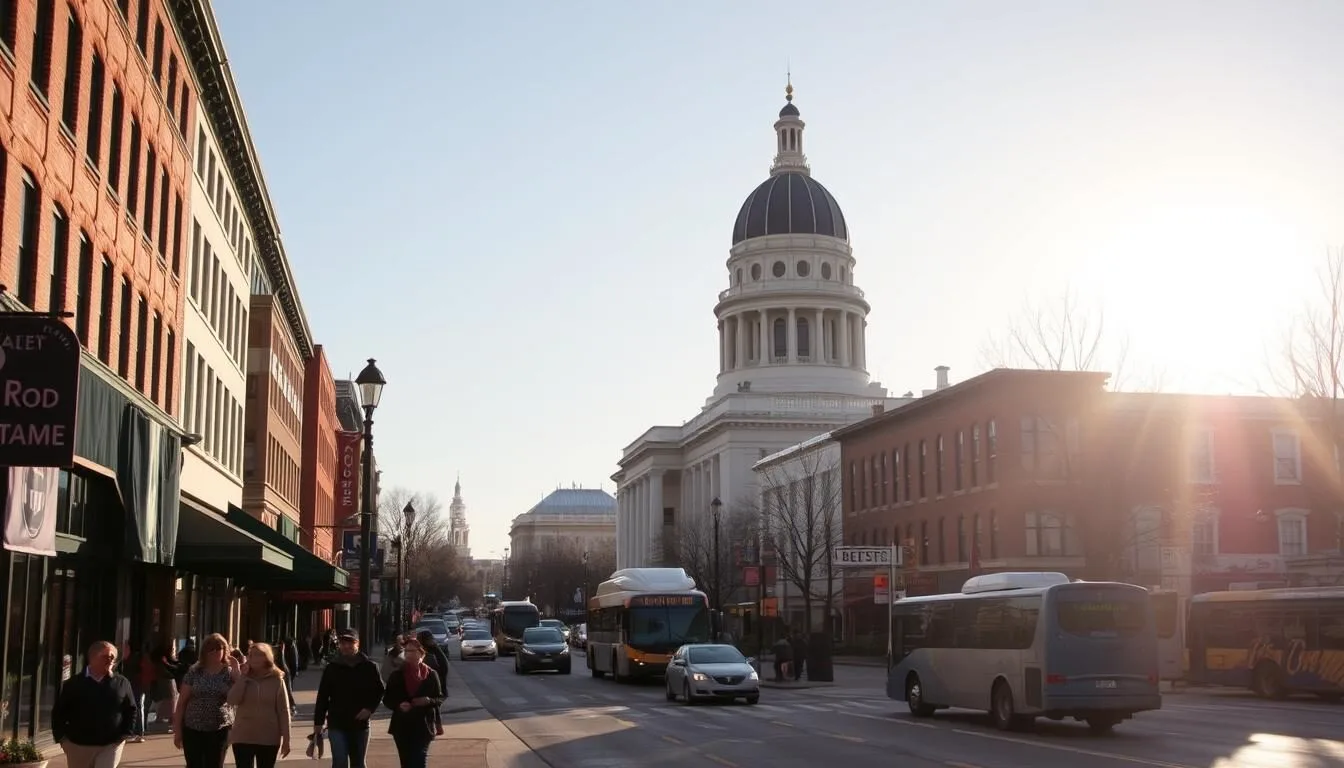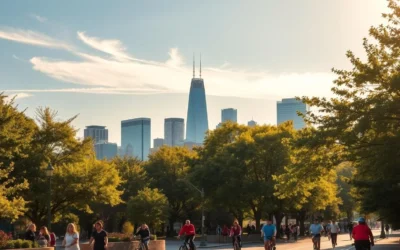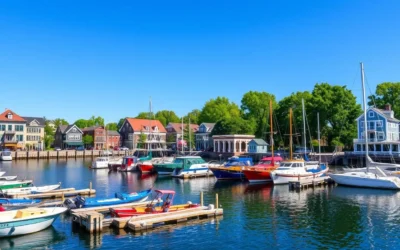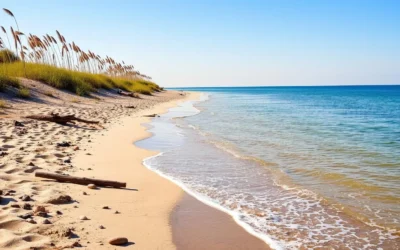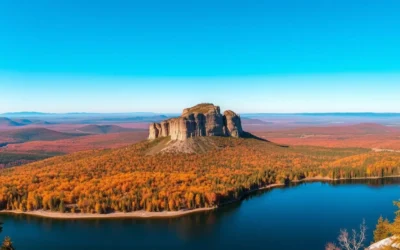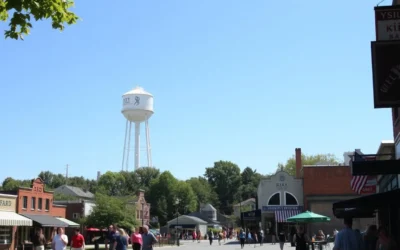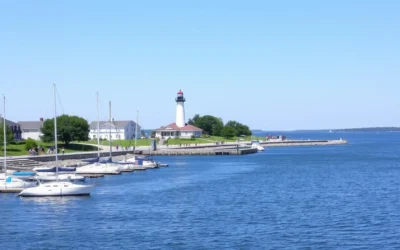✓ Accommodations✓ Flights✓ Rental Cars
Did you know that Lansing, the capital city of Michigan, experiences a significant variation in temperature and precipitation throughout the year? This four-season climate means that the time of your visit can greatly impact your experience.
Understanding the local climate and seasonal variations is crucial for planning a successful trip that aligns with your preferred activities and comfort levels. Whether you’re interested in outdoor recreation, cultural events, or indoor attractions, timing your visit strategically can significantly enhance your experience in Lansing.
By exploring the weather patterns and identifying the optimal months to visit, you’ll be able to make the most of your trip and create lasting memories.
Understanding Lansing’s Four-Season Climate
Lansing’s climate is characterized by four distinct seasons, each with its unique weather patterns. This variation significantly impacts the temperature, precipitation, and overall weather conditions throughout the year.
Temperature Variations Throughout the Year
Lansing experiences a continental climate with cold winters and warm summers. The temperature varies significantly over the year, with cold winters that can drop below freezing and warm summers that can reach into the 80s (°F). Understanding these temperature fluctuations is crucial for planning activities and packing appropriately for your visit.
Precipitation Patterns and Snowfall
Lansing sees significant seasonal variation in monthly rainfall. September is the wettest month, with an average of 3.0 inches of rain, while January is the driest, with only about 0.7 inches. The snowy period lasts for 4.9 months, from November 13 to April 9, with January receiving the most snow, averaging 5.6 inches. Understanding these precipitation patterns can help you prepare for your trip. The image below illustrates the seasonal variation in Lansing’s climate.
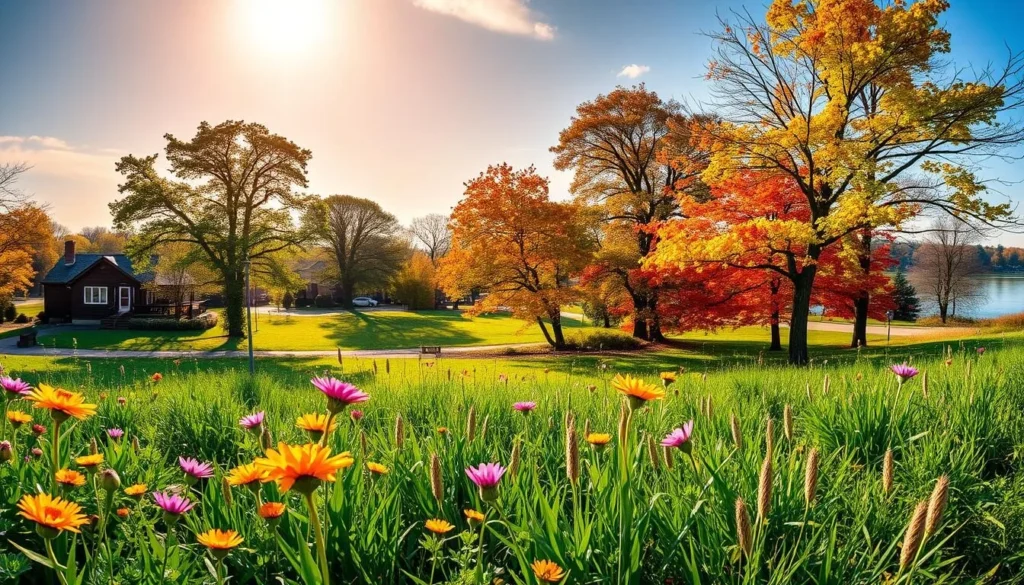
Precipitation occurs year-round but follows seasonal patterns. Snowfall is a significant factor during the winter months, creating potentially challenging travel conditions. By understanding these patterns, you can better plan your activities and pack accordingly.
Summer in Lansing: June Through August
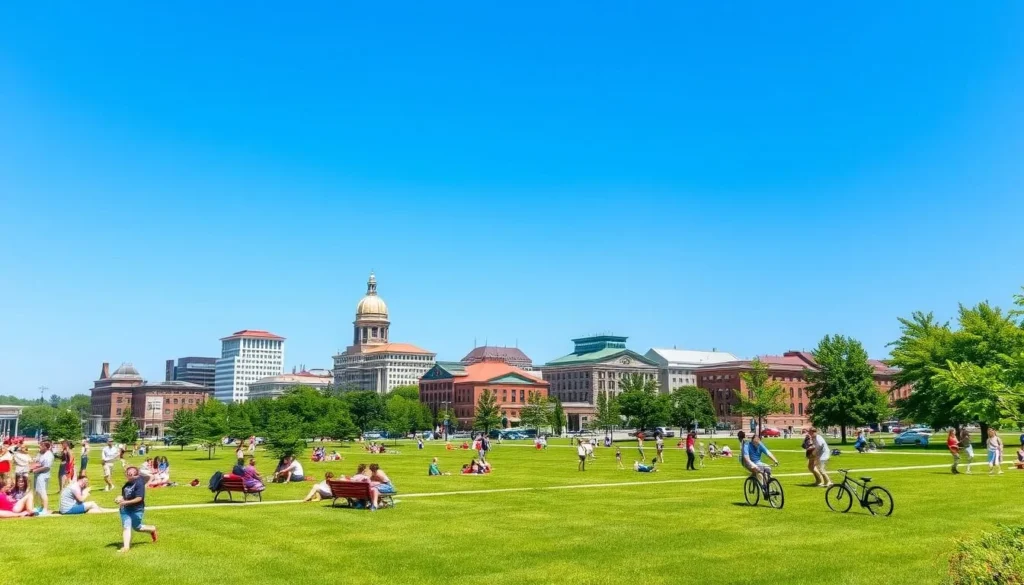
With the arrival of summer, Lansing’s natural beauty and outdoor recreational opportunities take center stage. You can enjoy the warm weather and numerous activities that the city has to offer.
Temperature and Humidity Levels
During the summer, Lansing experiences warm temperatures, with average highs often reaching the mid-80s (°F). The humidity levels can be relatively high, making it feel warm and muggy at times. You should be prepared for these conditions when planning your outdoor activities.
Summer Festivals and Events
Lansing hosts a variety of festivals and events during the summer, catering to different interests. You can enjoy cultural festivals, outdoor concerts, and community events that take place throughout the city. These events are a great way to experience the local culture and meet new people.
Outdoor Recreation Opportunities
Summer is an ideal time to explore Lansing’s outdoor recreational opportunities. You can enjoy swimming, kayaking, or paddleboarding on the Grand River, or visit Hawk Island County Park for its popular swimming beach and splash pad. Cycling enthusiasts can ride along the 13-mile Lansing River Trail, which offers scenic views of the surrounding natural areas and urban landscapes.
Fall in Lansing: September Through November
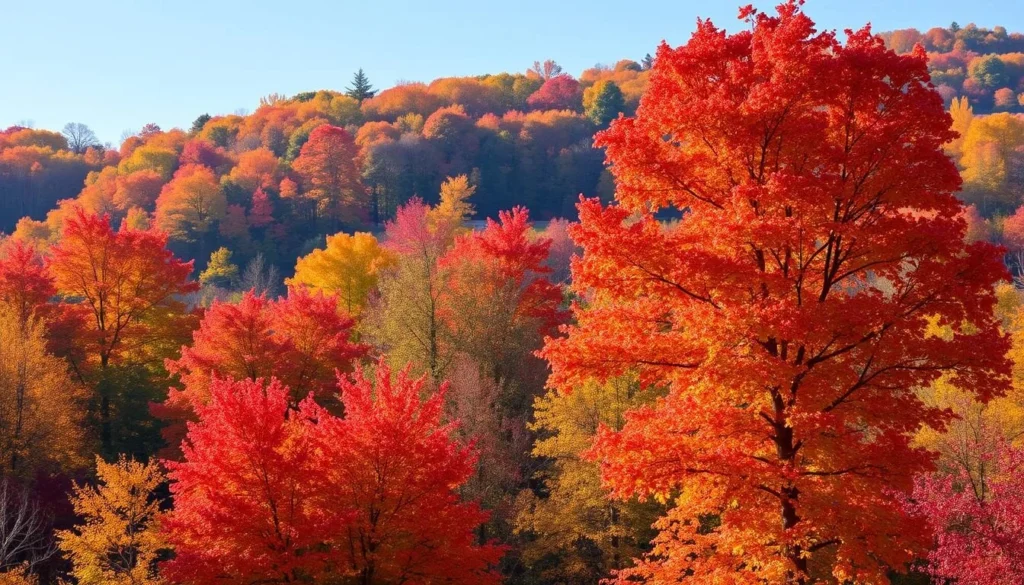
You’re in for a treat as Lansing’s fall season unfolds with its picturesque landscapes and engaging events. The fall season in Lansing, Michigan, is a time of transition, bringing a kaleidoscope of colors and a variety of activities that celebrate the harvest season.
Changing Colors and Scenic Beauty
The fall season is renowned for its breathtaking display of autumn colors. As the leaves change, the scenery around Lansing becomes even more picturesque, offering numerous opportunities for outdoor activities like hiking and photography. The changing colors create a beautiful backdrop for your fall adventures.
Fall Weather Patterns
During the fall, Lansing experiences a gradual cooling of temperatures, with September being relatively mild and November getting quite chilly. It’s a good idea to pack layers for your visit to enjoy the crisp autumn air. Understanding the weather patterns can help you plan your activities and make the most of your trip.
Harvest Festivals and Seasonal Activities
Fall in Lansing is also a time for harvest festivals and autumn events, celebrating the region’s agricultural heritage. Some of the highlights include:
- Harvest-themed events celebrating the local agricultural bounty
- Visits to apple orchards and cider mills for seasonal treats
- The Michigan Apple Festival, showcasing the state’s famous apple crop
- Halloween events, ranging from family-friendly pumpkin patches to haunted attractions
- Michigan State University football games, a central weekend activity that brings energy to the community
These activities make fall a great season to visit Lansing, offering something for everyone throughout the year.
Winter in Lansing: December Through February
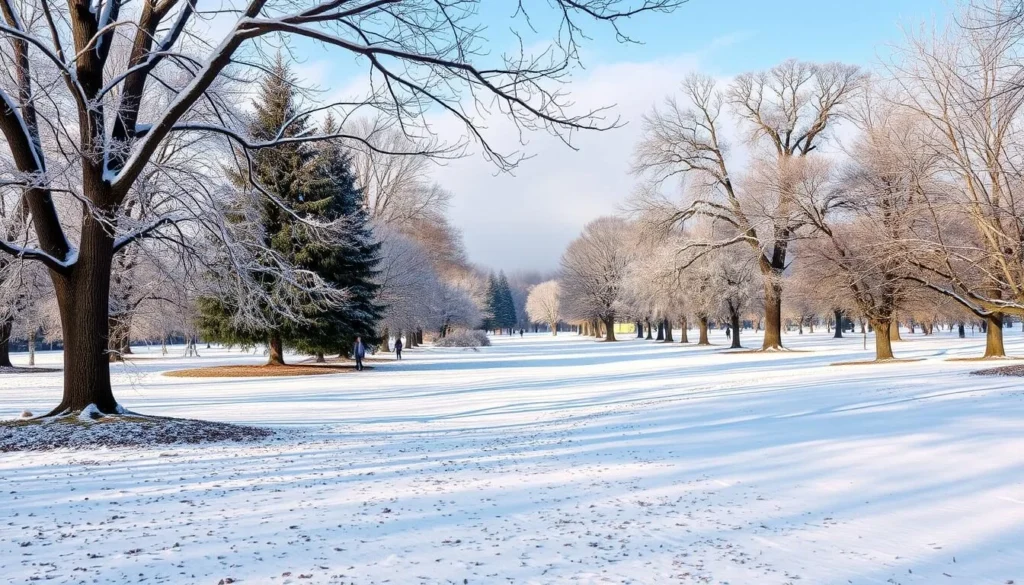
Winter in Lansing, Michigan, brings chilly temperatures and snow, creating a perfect backdrop for both outdoor and indoor adventures. As you plan your trip, understanding the weather conditions and available activities is crucial.
Snowfall and Temperature Trends
Lansing experiences significant snowfall during the winter months, with an average annual snowfall of around 35 inches. Temperatures often drop below freezing, with January being the coldest month, averaging temperatures around 24°F (-4°C).
Winter Sports and Recreation
Despite the cold, Lansing offers numerous opportunities for winter sports and recreation. You can enjoy ice skating, skiing, and snowshoeing in the city’s parks and recreational areas. The nearby Pinckney Recreation Area is a favorite among locals for its cross-country skiing trails and snow-covered landscapes.
Indoor Attractions During Cold Months
When you need a break from the cold, Lansing’s indoor attractions become especially appealing. The Michigan History Center offers engaging exhibits about the state’s past in a comfortable indoor environment. The Impression5 Science Center provides interactive learning experiences perfect for families seeking indoor activities. Additionally, the Wharton Center for Performing Arts presents its most robust calendar during winter months, featuring Broadway shows, concerts, and other performances.
Winter is also an excellent time to explore Lansing’s diverse dining scene, with restaurants offering cozy atmospheres and seasonal menus. Whether you’re looking for outdoor adventures or indoor comforts, Lansing has something to offer during the winter season.
Spring in Lansing: March Through May
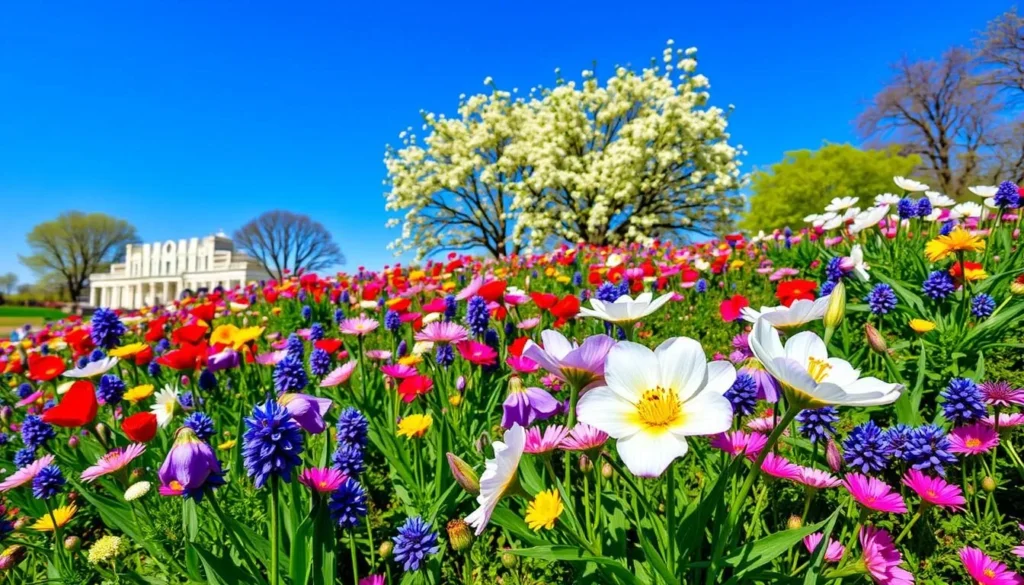
As winter fades, Lansing transforms into a vibrant city full of life and color during the spring season. The period from March to May is marked by a gradual warming of the weather, making it an ideal time to enjoy outdoor activities.
Spring Thaw and Temperature Patterns
During the spring, Lansing experiences a significant thaw, with temperatures rising steadily. Daytime temperatures often reach the 60s and 70s (Fahrenheit) by late May, while nighttime temperatures can still be cool, ranging from the 40s to 50s.
Blooming Season and Natural Beauty
Spring is a time of blooming beauty in Lansing. The city’s parks and gardens come alive with flowers, and the surrounding countryside is adorned with blossoming trees. This natural beauty makes spring an excellent time for outdoor recreation, such as hiking and biking, as trails dry out and temperatures become more comfortable.
Spring Events and Activities
Spring in Lansing is also a time for various events and activities. The season hosts maple syrup festivals in March, Earth Day celebrations in April, and the opening of farmers markets and outdoor concert series in May. These events celebrate the return of warmer weather and outdoor activities after the winter months.
Some of the notable spring events include the Maple Syrup Festival at Fenner Nature Center, which showcases traditional syrup-making techniques, and Earth Day celebrations featuring environmental education activities and community clean-up events. Farmers markets begin reopening in May, bringing fresh local produce and artisanal products back to the community.
Lansing, Michigan: Best Months for a Weather-Savvy Trip
If you’re planning a trip to Lansing, Michigan, knowing the ideal months to visit can make all the difference. The city’s climate varies throughout the year, making some months more suitable for certain activities than others.
May and June: Perfect Balance of Weather and Activities
May and June are excellent months to visit Lansing, offering a perfect blend of pleasant weather and exciting activities. During this period, temperatures are mild, making it ideal for outdoor exploration. You can enjoy hiking, biking, and scenic drives as the city’s parks and natural areas come alive with blooming flowers and greenery.
The weather is characterized by gradually warming temperatures, typically ranging from the 50s to 70s°F. This comfortable climate is perfect for participating in various outdoor events and festivals that take place during these months.
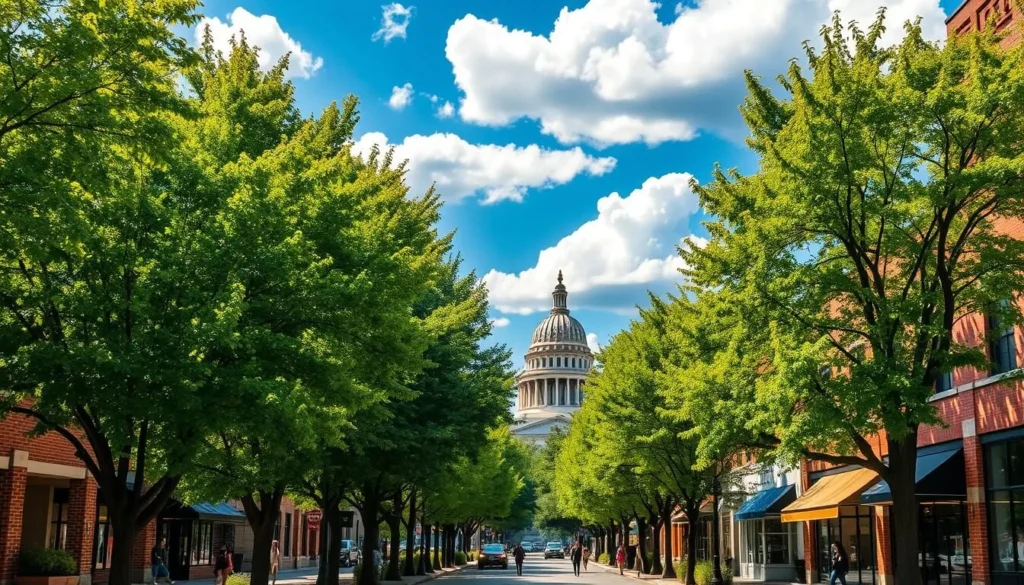
September and October: Ideal for Fall Experiences
September and October represent another prime period for visiting Lansing, combining comfortable temperatures with stunning fall scenery. These months feature gradually cooling temperatures that remain pleasant for outdoor activities.
| Month | Temperature Range (°F) | Activities |
|---|---|---|
| September | 50-70 | Hiking, biking, scenic drives, harvest festivals |
| October | 40-60 | Fall foliage, photography, seasonal events |
Fall foliage reaches its peak in October, transforming Lansing’s parks and streets into a colorful spectacle. The drop in humidity levels from summer peaks creates crisp, comfortable air that’s ideal for active exploration. These months offer a perfect balance of reasonable accommodation rates, smaller crowds, and excellent weather conditions, making them ideal for a weather-savvy trip.
Cloud Cover and Sunshine in Lansing
Lansing experiences a mix of clear and cloudy days throughout the year, affecting various activities. The clearer part of the year in Lansing begins around May 24 and lasts for 5.2 months, ending around October 31. This period is crucial for outdoor enthusiasts and those who enjoy sunshine.
The Clearest and Cloudiest Months
The clearest months in Lansing are typically during the late spring and early fall. August is often the sunniest month, while December and January tend to be the cloudiest. Understanding these patterns can help you plan your activities accordingly.
| Month | Average Cloud Cover | Average Sunshine Hours |
|---|---|---|
| August | Partial | 9 hours |
| December | Mostly Cloudy | 2 hours |
| January | Mostly Cloudy | 2.5 hours |
Impact on Outdoor Activities
Cloud cover significantly impacts outdoor activities in Lansing. The clearer summer days provide optimal conditions for recreation, while the extended period of clearer skies from late May through October creates ideal conditions for outdoor photography, sports, and sightseeing. Even during cloudier months, breaks in cloud cover provide opportunities for outdoor activities. Some activities, like fall color viewing, can be enhanced by partial cloud cover, creating dramatic lighting conditions.
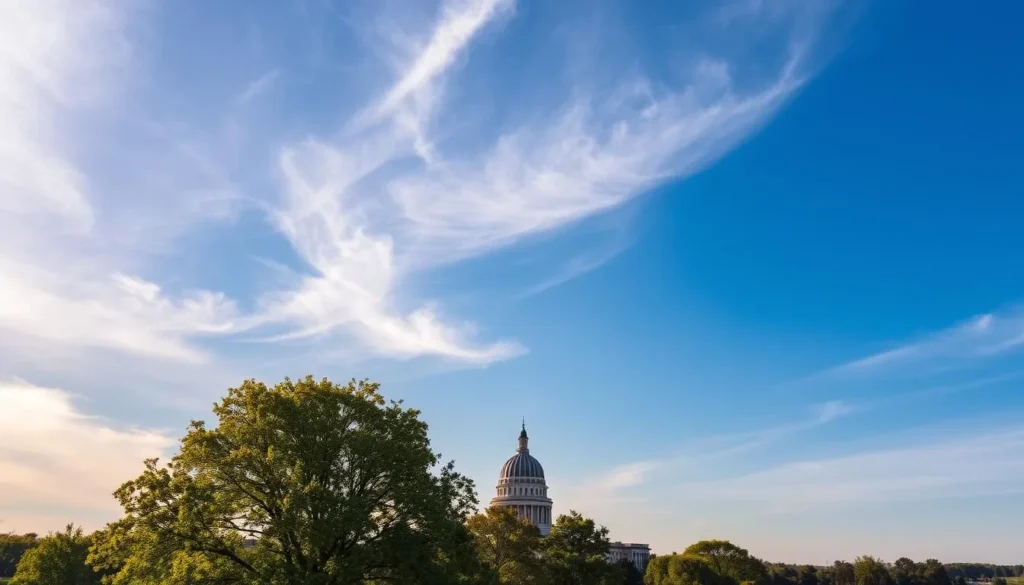
By understanding Lansing’s cloud cover and sunshine patterns, you can better plan your day and make the most of your visit, whether you’re engaging in outdoor activities or simply enjoying the scenic beauty.
Rainfall and Humidity Considerations
Lansing’s climate is characterized by significant variations in humidity and rainfall throughout the year. Understanding these factors is crucial for planning a comfortable and enjoyable trip.
Wettest and Driest Periods
Lansing experiences its most significant humidity during the summer months, with July being the most muggy, averaging 9.7 days of muggy or worse conditions. Conversely, the winter months, particularly from November to March, are very dry, with February 21 being the least muggy day of the year. The average rainfall in Lansing also varies, contributing to the overall moisture conditions that impact outdoor comfort.
The wettest period in Lansing is generally during the spring and early summer, while the driest period is usually during the winter months. This variation affects the perceived comfort level, regardless of the temperature.
Comfort Levels Throughout the Year
The comfort level in Lansing varies significantly throughout the year due to changes in humidity. The muggier period lasts for approximately 3.6 months, from June 1 to September 19, during which the comfort level is muggy, oppressive, or miserable at least 8% of the time. In contrast, spring and fall generally offer the most comfortable humidity levels, making them appealing travel seasons. Average rainfall, combined with humidity, creates varying moisture conditions that impact outdoor comfort throughout the year.
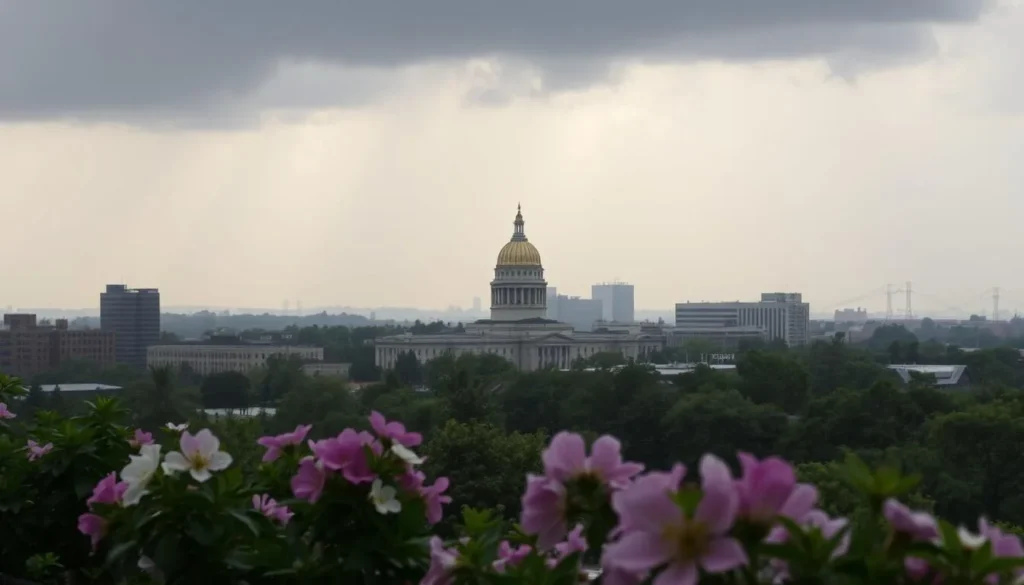
Wind Patterns in Lansing
Understanding the wind patterns in Lansing is crucial for visitors to prepare for the varying weather conditions. The predominant average hourly wind direction in Lansing is from the west throughout the year, bringing different air masses that affect temperature and humidity levels.

Seasonal Wind Speed Variations
The wind speed in Lansing varies significantly across different seasons. January typically experiences the highest average wind speeds, contributing to the most challenging wind chill conditions of the year. In contrast, summer months bring gentler breezes that provide welcome relief during hot periods.
Impact on Perceived Temperature
The wind significantly impacts how temperatures feel in Lansing, particularly during winter months when wind chill can dramatically lower perceived temperatures. Understanding these wind patterns helps you prepare for the actual comfort conditions you’ll experience rather than simply relying on temperature readings.
Planning Around Daylight Hours
Lansing’s daylight hours vary significantly throughout the year, impacting your outdoor activities and travel plans. As you plan your visit, understanding these variations can help you make the most of your time in the city.
Longest and Shortest Days
The earliest sunrise in Lansing occurs on June 15 at 5:59 AM, while the latest sunrise is on November 1 at 8:12 AM, a difference of 2 hours and 13 minutes. Conversely, the earliest sunset is on December 8 at 5:04 PM, and the latest sunset is on June 26 at 9:20 PM, a difference of 4 hours and 16 minutes. This significant variation affects the length of your day and the timing of your activities.
| Season | Earliest Sunrise | Latest Sunset | Daylight Hours |
|---|---|---|---|
| Summer | 5:59 AM (June 15) | 9:20 PM (June 26) | 15+ hours |
| Winter | 8:12 AM (Nov 1) | 5:04 PM (Dec 8) | 9 hours |
Maximizing Daylight for Activities
You can maximize your outdoor activities by planning around these daylight hours. For instance, summer visitors can take advantage of early sunrises and late sunsets to enjoy more outdoor time. In contrast, winter visitors should schedule their outdoor activities during midday when temperatures are warmest and daylight is available. 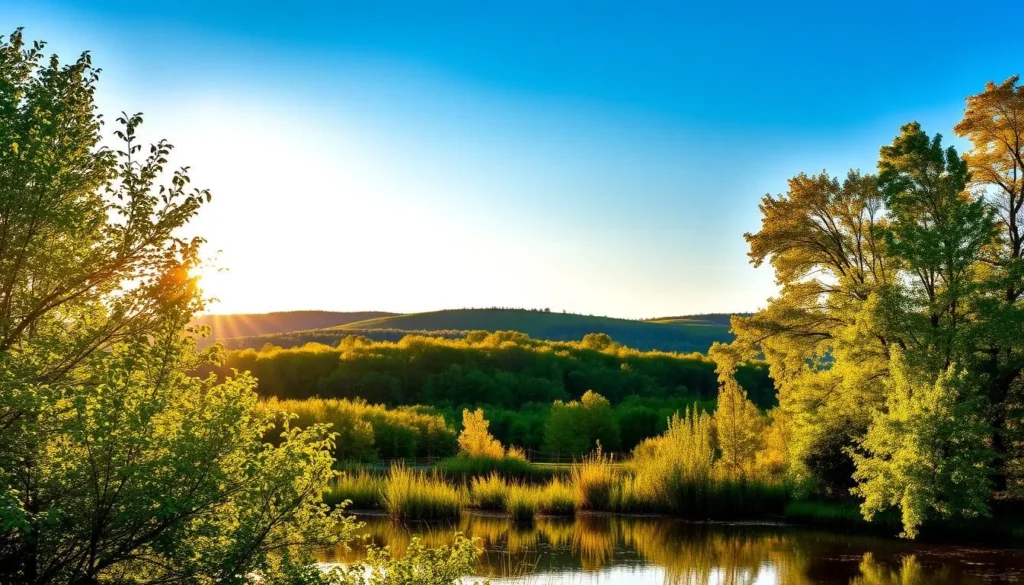
By being mindful of Lansing’s daylight hours, you can optimize your itinerary and enjoy a more fulfilling trip, whether you’re engaging in outdoor activities or simply enjoying the city’s scenery.
Weather-Based Packing Guide for Lansing
To make the most of your trip to Lansing, it’s essential to understand the city’s seasonal weather patterns and pack accordingly. Regardless of when you visit, being prepared for the local climate will enhance your experience.
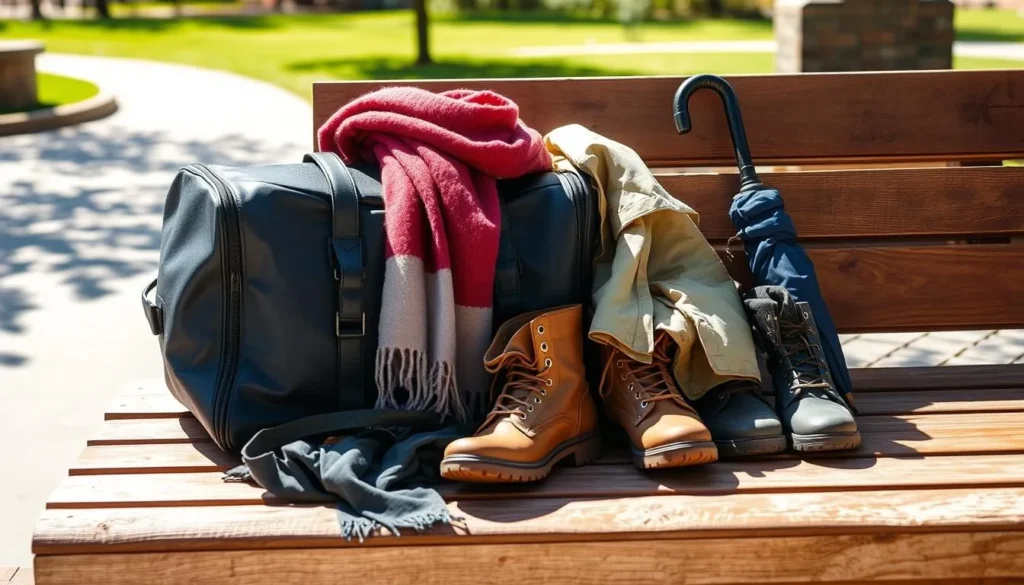
Summer Essentials
During the summer months, lightweight and breathable clothing is a must to combat the warm temperatures. Don’t forget to pack sunscreen, sunglasses, and a hat to protect yourself from the sun. Comfortable walking shoes are also essential for exploring Lansing’s outdoor attractions.
Fall Necessities
In the fall, Lansing experiences a range of temperatures, making layering pieces crucial. As the season progresses, it can get cooler, especially in the mornings and evenings, so packing a light jacket or sweater is advisable. Enjoy the fall foliage with comfortable shoes suitable for walking.
Winter Must-Haves
Winter in Lansing can be quite cold, so it’s vital to pack warm clothing, including a heavy coat, gloves, and a hat. Waterproof boots are also a must for navigating potentially snowy and icy conditions. Consider packing thermal layers for extra warmth.
Spring Packing List
Spring brings variable temperatures and frequent rain showers, so it’s wise to pack versatile layering pieces and waterproof gear. Include comfortable, waterproof footwear for potentially muddy conditions and don’t forget an umbrella for those spring showers. If you’re sensitive to pollen, consider packing allergy medications.
Throughout the year, Lansing’s weather can be quite diverse, so checking the forecast before your trip and being prepared for seasonal rain will ensure a smooth and enjoyable visit.
Indoor Attractions for Inclement Weather Days

Discover the best of Lansing’s indoor attractions, where you can escape the weather and indulge in a world of culture, shopping, and fun. The city offers a variety of activities to enjoy on a rainy or cold day, ensuring that your trip to Lansing remains memorable regardless of the weather.
Museums and Cultural Venues
Lansing is home to several museums and cultural venues that are perfect for a day out when the weather is not favorable. You can explore the city’s rich history, art, and science in a warm and welcoming environment. Some of the top recommendations include visiting local art galleries and museums that showcase the area’s cultural heritage.
Shopping and Entertainment Options
For those looking for some retail therapy or entertainment, Lansing has plenty to offer. You can visit The Lansing Mall or Meridian Mall for a climate-controlled shopping experience with a variety of retail options and dining choices. Old Town Lansing is another great destination, featuring unique boutiques, art galleries, and specialty shops. Additionally, you can catch a show or concert at The Wharton Center for Performing Arts, or explore the city’s growing craft brewery scene.
On a day when the rain is pouring down or snow is falling heavily, you can enjoy movie theaters throughout the city, or visit indoor farmers markets that operate during the winter months, offering local products. These entertainment options ensure that even a full day of rain or snow won’t derail your Lansing experience.
Conclusion: Making the Most of Lansing’s Weather
To make the most of your trip to Lansing, it’s essential to consider the city’s seasonal weather variations. Lansing’s four-season climate creates distinct experiences throughout the year, each with its own appeal depending on your preferences. The best time to visit depends on your tolerance for temperature extremes and the activities you’re most interested in experiencing.
May-June and September-October offer the most balanced weather conditions for general tourism, combining comfortable temperatures with reasonable precipitation levels. Understanding Lansing’s weather patterns will help you pack appropriately and plan activities that maximize your enjoyment. With proper preparation, Lansing can be an enjoyable destination in any season, offering year-round attractions and experiences that showcase the best of Michigan’s capital city.
- Lansing offers a unique experience in every season.
- Plan your visit according to your preferred activities and weather conditions.
The above is subject to change.
Check back often to TRAVEL.COM for the latest travel tips and deals.
